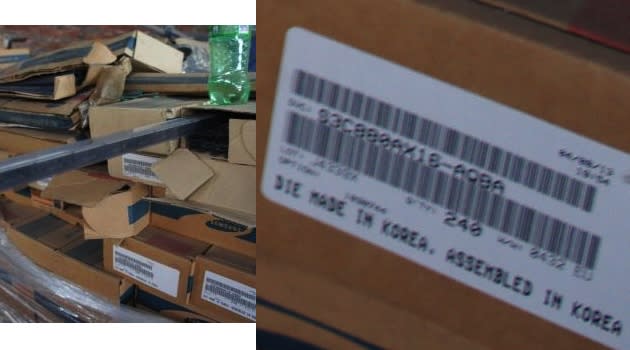Samsung Responds, Denies Dumping E-Waste in China

Yesterday we looked at photographic evidence that suggested that some manufacturers - namely Samsung, HP, Panasonic, and AMD - were dumping new but defective gadgets and parts in the notorious Guiyu landfill in southern China. Now Samsung (005930:KS) has reached out to us, and denied that it was done directly be the company, and that the semi-conductors found in the dump (pictured above) were “old” and ditched there by an unknown user - not by Samsung or its “recycling partners.”
The Samsung-branded parts were the ones most difficult to pin down, as they lacked documentation that explained how the apparently unused components got to the toxic landfill. But there was paperwork attached to items from HP (NYSE:HPQ - News) and Panasonic (TYO:6752) which still suggest a more direct path from the factory or repair center to the trash heaps at Guiyu. Neither HP nor Panasonic, however, have explained how the “out of warranty” and sent for “repair” parts made it to the vast and dangerous landfill.
To give Samsung a full right-of-reply, here’s the Korean manufacturer’s official response to us from its Seoul HQ:
Samsung Electronics actively promotes the take back and recycling of electronic products as part of its commitment to environmental stewardship. As an inaugural E-Stewards Enterprises member with the Basel Action Network, Samsung is committed to enforcing strict global standards for proper e-waste management to protect the environment, people, and developing countries from the hazards of electronic waste. Samsung has established recycling programs all over the world to comply with global recycling laws, and we are expanding voluntary programs, regardless of legal requirements, to continue to minimize electronic waste.
Based on our internal investigation, we confirmed that the boxes were not discarded by Samsung Electronics or by one of Samsung’s recycling partners. Furthermore, the semiconductor components contained in the boxes were manufactured in 2004 and had been shipped to a customer overseas. In the case of components - unlike finished products - all rights and ownership are transferred to the customer after a sales transaction has been completed.
That last part is the most crucial, claiming evidence that the components were not put there by the company itself. Samsung also promised it “will continue to investigate this matter and share new information as it becomes available.”
We’re reaching out to HP and Panasonic as well, and hope that they can shed some light on all the documentation attached to the dumped items, which seem to suggest a more direct link to those companies.
Note that the original discovery was made on the Shanghai Scrap blog, which is worth reading if you’re interested in e-waste as a global consumer and environmental issue.


